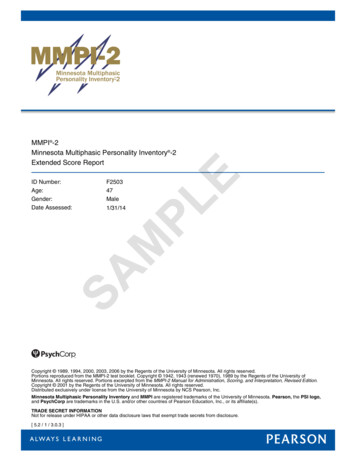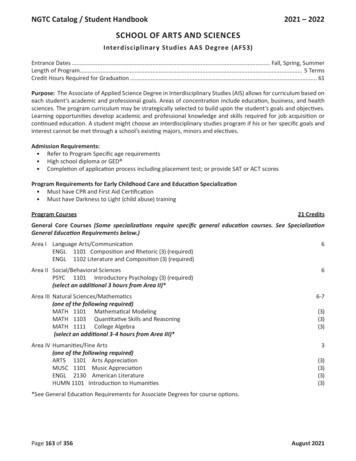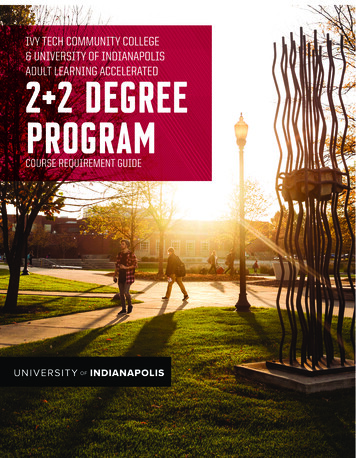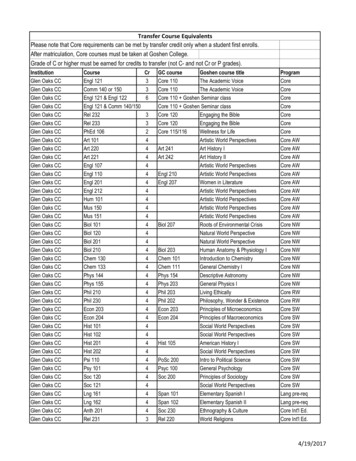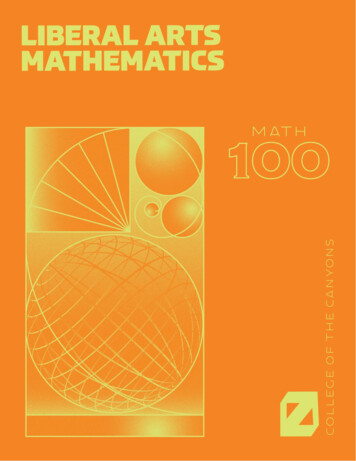
Transcription
1 Math 100
Liberal Arts MathematicsAn Open Educational Resources Publication by College of theCanyonsAuthored and compiled by Saburo MatsumotoEditors: Alex Gavilan & Trudi RadtkeCover by: Ian Joslinhttps://koolkoalaj.com/Version 120192 Math 100
AcknowledgementsWe would like to extend appreciation to the following peopleand organizations for allowing this textbook to be created:California Community Colleges Chancellor’s OfficeChancellor Dianne G. Van HookSanta Clarita Community College DistrictCollege of the Canyons Distance Learning Office*Unless otherwise noted, the content in this textbook is licensed under CC BY 4.03 Math 100
Table of ContentsChapter 1: Mathematics and Problem-Solving1.1 Fallacies in Common Language771.2 Propositions and Logic101.3 Truth Tables161.4 Analyzing Arguments311.5 Problem Solving44Chapter 2: Mathematics and Numbers582.1 Percentages and Proportions582.2 Conversions642.3 Estimating the Answer702.4 Really Big and Really Small Numbers752.5 Deceptive and Misleading Numbers77Chapter 3: Mathematics and Finance913.1 Simple and Compound Interest913.2 Annuities and Loans983.3 Continuous Compounding1073.4 Federal Budgets and National Debt109Chapter 4: Probability and Odds1164.1 Basic Concepts1164.2 Conditional Probability1234.3 Counting1284.4 Expected Value140Chapter 5: Data and Statistics1535.1 Basics of Statistics1535.2 Describing Data1675.3 Numerical Measures of Center and Variation1795.4 Normal Distribution194Chapter 6: Growth and Decay2066.1 Growth Models2066.2 Logarithmic Scales in Natural Sciences2176.3 The pH Scale2214 Math 100
Chapter 7: Mathematics and the Arts2317.1 Projective Geometry2317.2 The Golden Ratio and Fibonacci Sequence2357.3 Musical Scales2387.4 Fractals244Chapter 8: Mathematics and Politics2568.1 Apportionment2568.2 Apportionment of Legislative Districts2728.3 Voting Theory2758.4 Weighted Voting294Chapter 9: Selected Topics3179.1 Four Color Theorem3179.2 How Big is Infinity? Or Is it “Infinities”?3199.3 “Seven Bridges of Konigsberg.”3269.4 Russell’s Paradox3289.5 Non-Euclidean Geometry329Appendix A - Try it Now Answers3351.1 Logic3352.1 Problem Solving3373.1 Finance3394.1 Basic Concepts in Statistics3405.1 Statistics3415.2 Describing Data3426.1 Growth Models3436.2 Logarithmic Scales in Natural Sciences3447.4 Fractals3458.2 Voting Theory3468.3 Weighted Voting347Appendix B: Solutions to Selected Exercises350Problem Solving350Finance351Statistics3535 Math 100
Describing Data354Growth Models356Fractals358Apportionment358Voting Theory359Weighted Voting360References6 Math 100363
Chapter 1: Mathematics and Problem-SolvingWe are surrounded by information—information in various forms such as numbers, charts, graphs,figures, sentences, songs, speeches, and conversations. Much of the information comes through mediaincluding television, magazines, and online communications. Many of the things we hear and read aretrue while many are not. How are we to determine what is true and what is not? What is truth anyway?Are there ways to detect false information? What are we to watch out for?One of the primary goals of this book is to answer some of these questions through logic andmathematics. This is particularly important in the Internet-dominated, media-centered, andinformation-driven age in which we find ourselves living today. With new technologies, it is becomingmuch easier for businesses and organizations to send out deceptive messages and misleadingadvertisements, and they can target specific individuals based on their online activities. Throughout thisbook you will find data, numbers, and statements that can be presented honestly or dishonestly in adeceptive manner. They may be numbers, percentages, odds, statistics, or written sentences.In this first chapter we study logic, both correct use of logic and logical fallacies. Before we get into theformal side of logic, however, we first look at some types of fallacies presented as English sentences. Inother words, we will see some bad examples of logical arguments presented in common language. Then,in the following sections we will look carefully into some formal components of logic like propositions,truth tables, and logical equivalences.1.1 Fallacies in Common LanguageiIn the previous discussion, we saw that logical arguments can be invalid when the premises are not true,when the premises are not sufficient to guarantee the conclusion, or when there are invalid chains inlogic. There are a number of other ways in which arguments can be invalid, a sampling of which aregiven here.Ad hominem (Personal Attack)An ad hominem argument attacks the person making the argument, ignoring the argumentitself.Example 1“Jane says that whales aren’t fish, but she’s only in the second grade, so she can’t be right.”Here the argument is attacking Jane, not the validity of her claim, so this is an ad hominemargument.Example 2“Jane says that whales aren’t fish, but everyone knows that they’re really mammals. She’s sostupid.”This certainly isn’t very nice, but it is not ad hominem since a valid counterargument is madealong with the personal insult.7 Math 100
Appeal to ignoranceThis type of argument assumes something is true because it hasn’t been proven false.Example 3“Nobody has proven that photo isn’t of Bigfoot, so it must be Bigfoot.” “I know there are aliensin space because science has not yet eliminated the possibility”Appeal to authorityThese arguments attempt to use the authority of a person to prove a claim. While oftenauthority can provide strength to an argument, problems can occur when the person’sopinion is not shared by other experts, or when the authority is irrelevant to the claim.Example 4“A diet high in bacon can be healthy; Doctor Atkins said so.”Here, an appeal to the authority of a doctor is used for the argument. This generally wouldprovide strength to the argument, except that the opinion that eating a diet high in saturated fatruns counter to general medical opinion. More supporting evidence would be needed to justifythis claim.Example 5“Jennifer Hudson lost weight with Weight Watchers, so their program must work.”Here, there is an appeal to the authority of a celebrity. While her experience does provideevidence, it provides no more than any other person’s experience would.Appeal to consequenceAn appeal to consequence concludes that a premise is true or false based on whether theconsequences are desirable or not.Example 6“Humans will travel faster than light: faster-than-light travel would be beneficial for spacetravel.”8 Math 100
False dilemma (Limited Choice)A false dilemma argument falsely frames an argument as an “either or” choice, withoutallowing for additional options.Example 7“Either those lights in the sky were an airplane or aliens. There are no airplanes scheduled fortonight, so it must be aliens.”This argument ignores the possibility that the lights could be something other than an airplaneor aliens.Circular reasoningCircular reasoning is an argument that relies on the conclusion being true for the premise tobe true.Example 8“I shouldn’t have gotten a C in that class; I’m an A student!”In this argument, the student is claiming that because he is an A student, he shouldn’t havegotten a C. But because he got a C, he is not an A student.Post hoc (false cause)A post hoc argument claims that because two things happened sequentially, then the firstmust have caused the second.Example 9“Today I wore a red shirt, and my football team won! I need to wear a red shirt every time theyplay to make sure they keep winning.”Straw manA straw man argument involves misrepresenting the argument in a less favorable way tomake it easier to attack.Example 10“Senator Jones has proposed reducing military funding by 10%. Apparently he wants to leave usdefenseless against attacks by terrorists”Here the arguer has represented a 10% funding cut as equivalent to leaving us defenseless,making it easier to attack Senator Jones’ position.9 Math 100
Correlation implies causationSimilar to post hoc, but without the requirement of sequence, this fallacy assumes that justbecause two things are related one must have caused the other. Often there is a thirdvariable not considered.Example 11“Months with high ice cream sales also have a high rate of deaths by drowning. Therefore, icecream must be causing people to drown.”This argument is implying a causal relation, when really both are more likely dependent on theweather; that ice cream and drowning are both more likely during warm summer months.Try it Now 20Identify the logical fallacy in each of the argumentsa. Only an untrustworthy person would run for office. The fact that politicians areuntrustworthy is proof of this.b. Since the 1950s, both the atmospheric carbon dioxide level and obesity levels haveincreased sharply. Hence, atmospheric carbon dioxide causes obesity.c. The oven was working fine until you started using it, so you must have broken it.d. You can’t give me a D in the class because I can’t afford to retake it.e. The senator wants to increase support for food stamps. He wants to take the taxpayers’hard-earned money and give it away to lazy people. This isn’t fair, so we shouldn’t do it.It may be difficult to identify one particular fallacy for an argument. Consider this argument: “EmmaWatson says she’s a feminist, but she posed for these racy pictures. I’m a feminist, and no selfrespecting feminist would do that.” Could this be ad hominem, saying that Emma Watson has no selfrespect? Could it be appealing to authority because the person making the argument claims to be afeminist? Could it be a false dilemma because the argument assumes that a woman is either a feministor not, with no gray area in between?1.2 Propositions and LogicLogic is, basically, the study of valid reasoning. When searching the internet, we use Boolean logic –terms like “and” and “or” – to help us find specific web pages that fit in the sets we are interested in.After exploring this form of logic, we will look at logical arguments and how we can determine thevalidity of a claim.Boolean LogicWe can often classify items as belonging to sets. If you went the library to search for a book and theyasked you to express your search using unions, intersections, and complements of sets, that would feel alittle strange. Instead, we typically using words like “and”, “or”, and “not” to connect our keywordstogether to form a search. These words, which form the basis of Boolean logic, are directly related toour set operations. (Boolean logic was developed by the 19th-century English mathematician GeorgeBoole.)10 Math 100
Boolean LogicBoolean logic combines multiple statements that are either true or false into anexpression that is either true or false.In connection to sets, a search is true if the element is part of the set.Suppose M is the set of all mystery books, and C is the set of all comedy books. If we search for“mystery”, we are looking for all the books that are an element of the set M; the search is true for booksthat are in the set.In connection to sets, a search is true if the element is part of the set.When we search for “mystery and comedy”, we are looking for a book that is an element of both sets, inthe intersection. If we were to search for “mystery or comedy”, we are looking for a book that is amystery, a comedy, or both, which is the union of the sets. If we searched for “not comedy”, we arelooking for any book in the library that is not a comedy, the complement of the set C.Connection to Set OperationsA and Belements in the intersection A BA or Belements in the union A Bnot Aelements in the complement AcNotice here that or is not exclusive. This is a difference between the Boolean logic use of the word andcommon everyday use. When your significant other asks “do you want to go to the park or the movies?”they usually are proposing an exclusive choice – one option or the other, but not both. In Boolean logic,the or is not exclusive – more like being asked at a restaurant “would you like fries or a drink with that?”Answering “both, please” is an acceptable answer.Example 1Suppose we are searching a library database for Mexican universities. Express a reasonablesearch using Boolean logic.We could start with the search “Mexico and university”, but would be likely to find results forthe U.S. state New Mexico. To account for this, we could revise our search to read:Mexico and university not “New Mexico”In most internet search engines, it is not necessary to include the word and; the search engineassumes that if you provide two keywords you are looking for both. In Google’s search, thekeyword or has be capitalized as OR, and a negative sign in front of a word is used to indicatenot. Quotes around a phrase indicate that the entire phrase should be looked for. The searchfrom the previous example on Google could be written:Mexico university -“New Mexico”11 Math 100
Example 2Describe the numbers that meet the condition:even and less than 10 and greater than 0The numbers that satisfy all three requirements are {2, 4, 6, 8}Sometimes statements made in English can be ambiguous. For this reason, Boolean logic usesparentheses to show precedent, just like in algebraic order of operations.Example 3Describe the numbers that meet the condition:odd number and less than 20 and greater than 0 and (multiple of 3 or multiple of 5)The first three conditions limit us to the set {1, 3, 5, 7, 9, 11, 13, 15, 17, 19}The last grouped conditions tell us to find elements of this set that are also either a multiple of 3or a multiple of 5. This leaves us with the set {3, 5, 9, 15}Notice that we would have gotten a very different result if we had written(odd number and less than 20 and greater than 0 and multiple of 3) or multiple of 5The first grouped set of conditions would give {3, 9, 15}. When combined with the last condition,though, this set expands without limits:{3, 5, 9, 15, 20, 25, 30, 35, 40, 45, }Example 4The English phrase “Go to the store and buy me eggs and bagels or cereal” is ambiguous; it isnot clear whether the requestors is asking for eggs always along with either bagels or cereal, orwhether they’re asking for either the combination of eggs and bagels, or just cereal.For this reason, using parentheses clarifies the intent:Eggs and (bagels or cereal) meansOption 1: Eggs and bagels, Option 2: Eggs and cereal(Eggs and bagels) or cereal meansOption 1: Eggs and bagels, Option 2: CerealBe aware that when a string of conditions is written without grouping symbols, it is often interpretedfrom the left to right, resulting in the latter interpretation.Conditional StatementsBeyond searching, Boolean logic is commonly used in spreadsheet applications like Excel to doconditional calculations. A statement is something that is either true or false. A statement like 3 5 istrue; a statement like “a rat is a fish” is false. A statement like “x 5” is true for some values of x andfalse for others. When an action or outcome depends on the value of a statement, it forms aconditional.12 Math 100
Statements and ConditionalsA statement is either true or false.A conditional is a compound statement of the form“if p then q” or “if p then q, else s”.Example 5In common language, an example of a conditional statement would be “If it is raining, then we’llgo to the mall. Otherwise we’ll go for a hike.”The statement “If it is raining” is the condition – this may be true or false for any given day. Ifthe condition is true, then we will follow the first course of action and go to the mall. If thecondition is false, then we will use the alternative and go for a hike.Example 6As mentioned earlier, conditional statements are commonly used in spreadsheet applicationslike Excel or Google Sheets. In Excel, you can enter an expression like IF(A1 2000, A1 1, A1*2)Notice that after the IF, there are three parts. The first part is the condition, and the second twoare calculations. Excel will look at the value in cell A1 and compare it to 2000. If that condition istrue, then the first calculation is used, and 1 is added to the value of A1 and the result is stored.If the condition is false, then the second calculation is used, and A1 is multiplied by 2 and theresult is stored.In other words, this statement is equivalent to saying “If the value of A1 is less than 2000, thenadd 1 to the value in A1. Otherwise, multiply A1 by 2”.Example 7The expression IF(A1 5, 2*A1, 3*A1) is used. Find the result if A1 is 3, and the result if A1 is 8.This is equivalent to sayingIf A1 5, then calculate 2*A1. Otherwise, calculate 3*A1If A1 is 3, then the condition is false, since 3 5 is not true, so we do the alternate action, andmultiply by 3, giving 3*3 9If A1 is 8, then the condition is true, since 8 5, so we multiply the value by 2, giving 2*8 16Example 8An accountant needs to withhold 15% of income for taxes if the income is below 30,000, and20% of income if the income is 30,000 or more. Write an expression that would calculate theamount to withhold.13 Math 100
Our conditional needs to compare the value to 30,000. If the income is less than 30,000, weneed to calculate 15% of the income: 0.15*income. If the income is more than 30,000, we needto calculate 20% of the income: 0.20*income.In words we could write “If income 30,000, then multiply by 0.15, otherwise multiply by 0.20”.In Excel, we would write: IF(A1 30000, 0.15*A1, 0.20*A1)As we did earlier, we can create more complex conditions by using the operators and, or, and not to joinsimpler conditions together.Example 9A parent might say to their child “if you clean your room and take out the garbage, then you canhave ice cream.”Here, there are two simpler conditions:1) The child cleaning her room2) The child taking out the garbageSince these conditions were joined with and, the combined conditional will be true only if bothsimpler conditions are true; if either chore is not completed, then the parent’s condition is notmet.Notice that if the parent had said “if you clean your room or take out the garbage, then you canhave ice cream”, then the child would need to complete only one chore to meet the condition.Suppose you wanted to have something happen when a certain value is between 100 and 300. To createthe condition “A1 300 and A1 100” in Excel, you would need to enter “AND(A1 300, A1 100)”.Likewise, for the condition “A1 4 or A1 6” you would enter “OR(A1 4, A1 6)”Example 10In a spreadsheet, cell A1 contains annual income, and A2 contains number of dependents.A certain tax credit applies if someone with no dependents earns less than 10,000, or ifsomeone with dependents earns less than 20,000. Write a rule that describes this.There are two ways the rule is met:income is less than 10,000 and dependents is 0, orincome is less than 20,000 and dependents is not 0.Informally, we could write these as(A1 10000 and A2 0) or (A1 20000 and A2 0)In Excel’s format, we’d writeIF(OR(AND(A1 10000, A2 0), AND(A1 20000, A2 0)), “you qualify”, “you don’t qualify”)14 Math 100
Quantified StatementsWords that describe an entire set, such as “all”, “every”, or “none”, are called universal quantifiersbecause that set could be considered a universal set. In contrast, words or phrases such as “some”,“one”, or “at least one” are called existential quantifiers because they describe the existence of at leastone element in a set.QuantifiersA universal quantifier states that an entire set of things share a characteristic.An existential quantifier states that a set contains at least one element.Something interesting happens when we negate – or state the opposite of – a quantified statement.Example 11Suppose your friend says “Everybody cheats on their taxes.” What is the minimum amount ofevidence you would need to prove your friend wrong?To show that it is not true that everybody cheats on their taxes, all you need is one person whodoes not cheat on their taxes. It would be perfectly fine to produce more people who do notcheat, but one counterexample is all you need.It is important to note that you do not need to show that absolutely nobody cheats on theirtaxes.Example 12Suppose your friend says “One of these six cartons of milk is leaking.” What is the minimumamount of evidence you would need to prove your friend wrong?In this case, you would need to check all six cartons and show that none of them is leaking. Youcannot disprove your friend’s statement by checking only one of the cartons.When we negate a statement with a universal quantifier, we get a statement with an existentialquantifier, and vice-versa.Negating a quantified statementThe negation of “all A are B” is “at least one A is not B”.The negation of “no A are B” is “at least one A is B”.The negation of “at least one A is B” is “no A are B”.The negation of “at least one A is not B” is “all A are B”.15 Math 100
Example 13“Somebody brought a flashlight.” Write the negation of this statement.The negation is “Nobody brought a flashlight.”Example 14“There are no prime numbers that are even.” Write the negation of this statement.The negation is “At least one prime number is even.”Try it Now 1Write the negation of “All Icelandic children learn English in school.”1.3 Truth TablesBefore we focus on truth tables, we’re going to introduce some symbols that are commonly used forand, or, and not.SymbolsThe symbol is used for and:A and B is notated A BThe symbol is used for or:A or B is notated A BThe symbol is used for not:not A is notated AYou can remember the first two symbols by relating them to the shapes for the union and intersection.A B would be the elements that exist in both sets, in A B. Likewise, A B would be the elementsthat exist in either set, in A B. When we are working with sets, we use the rounded version of thesymbols; when we are working with statements, we use the pointy version.Example 1Translate each statement into symbolic notation. Let P represent “I like Pepsi” and let Crepresent “I like Coke”.a. I like Pepsi or I like Coke.b. I like Pepsi and I like Coke.c. I do not like Pepsi.d. It is not the case that I like Pepsi or Coke.e. I like Pepsi and I do not like Coke.a. P Cb. P Cc. P16 Math 100
d. (P C)e. P CAs you can see, we can use parentheses to organize more complicated statements.Try it Now 2Translate “We have carrots or we will not make soup” into symbols. Let C represent “wehave carrots” and let S represent “we will make soup”.Because complex Boolean statements can get tricky to think about, we can create a truth table to keeptrack of what truth values for the simple statements make the complex statement true and false.Truth tableA table showing what the resulting truth value of a complexstatement is for all the possible truth values for the simplestatements.Example 2Suppose you’re picking out a new couch, and your significant other says “get a sectional orsomething with a chaise”.This is a complex statement made of two simpler conditions: “is a sectional”, and “has a chaise”.For simplicity, let’s use S to designate “is a sectional”, and C to designate “has a chaise”.A truth table for this situation would look like this:SCS or CTTTTFTFTTFFFIn the table, T is used for true, and F for false. In the first row, if S is true and C is also true, thenthe complex statement “S or C” is true. This would be a sectional that also has a chaise, whichmeets our desire. (Remember that or in logic is not exclusive; if the couch has both features, itmeets the condition.)17 Math 100
In the previous example about the couch, the truth table was really just summarizing what we alreadyknow about how the or statement work. The truth tables for the basic and, or, and not statements areshown below.ConjunctionDisjunctionNegationABA BABA BA ATTTTTTTFTFFTFTFTFTFFTTFFFFFFTruth tables really become useful when we analyze more complex Boolean statements.Example 3When we create the truth table, we need to list all the possible truth value combinations for Aand B. Notice how the first column contains 2 Ts followed by 2 Fs, and the second columnalternates T, F, T, F. This pattern ensures that all 4 combinations are considered.ABTTTFFTFFAfter creating columns with those initial values, we create a third column for the expression 𝐵.Now we will temporarily ignore the column for A and write the truth values for 𝐵.AB BTTFTFTFTFFFTNext we can find the truth values of A B, using the first and third columns.18 Math 100
AB BA BTTFTTFTTFTFFFFTTThe truth table shows that A B is true in three cases and false in one case. If you’rewondering what the point of this is, suppose it is the last day of the baseball season and twoteams, who are not playing each other, are competing for the final playoff spot. Anaheim willmake the playoffs if it wins its game or if Boston does not win its game. (Anaheim owns the tiebreaker; if both teams win, or if both teams lose, then Anaheim gets the playoff spot.) If A Anaheim wins its game and B Boston wins its game, then A B represents the situation“Anaheim wins its game or Boston does not win its game”. The truth table shows us thedifferent scenarios related to Anaheim making the playoffs. In the first row, Anaheim wins itsgame and Boston wins its game, so it is true that Anaheim makes the playoffs. In the secondrow, Anaheim wins and Boston does not win, so it is true that Anaheim makes the playoffs. Inthe third row, Anaheim does not win its game and Boston wins its game, so it is false thatAnaheim makes the playoffs. In the fourth row, Anaheim does not win and Boston does not win,so it is true that Anaheim makes the playoffs.Try it Now 3Create a truth table for this statement: ( 𝐀) 𝐁Example 4Create a truth table for the statement A (B C)It helps to work from the inside out when creating a truth table, and to create columns in thetable for intermediate operations. We start by listing all the possible truth value combinationsfor A, B, and C. Notice how the first column contains 4 Ts followed by 4 Fs, the second columncontains 2 Ts, 2 Fs, then repeats, and the last column alternates T, F, T, F. This pattern ensuresthat all 8 combinations are considered. After creating columns with those initial values, wecreate a fourth column for the innermost expression, B C. Now we will temporarily ignore thecolumn for A and focus on B and C, writing the truth values for B C.19 Math 100
ABCB FFTFFFFFFFNext we can find the negation of B C, working off the B C column we just created. (Ignorethe first three columns and simply negate the values in the B C column.)A B CB C (B C)20 Math 100TTTTFTTFTFTFTTFTFFFTFTTTFFTFTFFFTTFFFFFT
Finally, we find the values of A and (B C). (Ignore the second, third, and fourth columns.)ABCB C (B C)A (B It turns out that this complex expression is true in only one case: when A is true, B is false, and C is false.To illustrate this situation, suppose that Anaheim will make the playoffs if: (1) Anaheim wins, and (2)neither Boston nor Cleveland wins. TFF is the only scenario in which Anaheim will make the playoffs.Try it Now 4Create a truth table for this statement: ( 𝐀 𝐁) 𝐁Truth Tables: Conditional, BiconditionalWe discussed conditional statements earlier, in which we take an action based on the value of thecondition. We are now going to look at another version of a conditional, sometimes called animplication, which states that the second part must logically follow from the first.ConditionalA conditional is a logical compound statement in which astatement p, called the antecedent, implies a statement q, calledthe consequent.A conditional is written as p q and is translated as “if p, then q”.Example 5The English statement “If it is raining, then there are clouds is the sky” is a conditionalstatement. It makes sense because if the antecedent “it is raining” is true, then the consequent“there are clouds in the sky” must also be true.21 Math 100
Notice that the statement tells us nothing of what to expect if it is not raining; there might beclouds in the sky, or there might not. If the antecedent is false, then the consquent becomesirrelevant.Example 6Suppose you order a team jersey online on Tuesday and want to receive it by Friday so you canwear it to Saturday’s game. The website says that if you pay for expedited shipping, you willreceive the jersey by Friday. In what situation is the website telling a lie?There are four possible outcomes:1) You pay for expedited shipping and receive the jersey by Friday2) You pay for expedited shipping and don’t receive the jersey by Friday3) You don’t pay for expedited shipping and receive the jersey by Friday4) You don’t pay for expedited shipping and don’t receive the jersey by FridayOnly one of these outcomes proves that the website was lying: the second outcome in whichyou pay for expedited shipping but don’t receive the jersey by Friday. The first outcome isexactly what was promised, so there’s no problem with that. The third outcome is not a liebecause the website never said what would happen if you didn’t pay for expedited shipping;maybe the jersey would arrive by Friday whether you paid for expedited shipping or not. Thefourth outcome is not a lie because, again, the website didn’t make any promises about whenthe jersey would arrive if you didn’t pay for expedited shipping.It may seem strange that the third outcome in the previous example, in which the first part is false butthe second part is true, is not a lie. Remember, though, that if the antecedent is false, we cannot makeany judgment about the consequent. The website never said that paying for expedited shipping was theonly way to receive the jersey by Friday.Example 7A friend tells you “If you upload that picture to Facebook, you’ll lose your job.” Under wh
1.3 Truth Tables 16 1.4 Analyzing Arguments 31 1.5 Problem Solving 44 Chapter 2: Mathematics and Numbers 58 2.1 Percentages and Proportions 58 2.2 Conversions 64 2.3 Estimating the Answer 70 2.4 Really Big and Really Small Numbers 75 2.5 Deceptive and Misleading Numbers 77 Chapter 3: Mathematics and Finance 91



